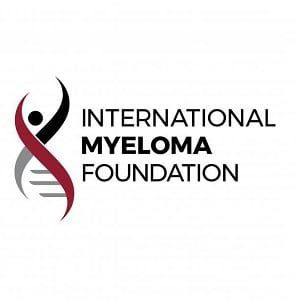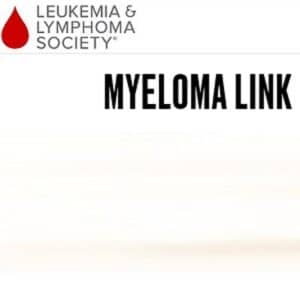Multiple Myeloma Disparities
- more than twice as likely to be diagnosed with multiple myeloma
- almost three times more likely to be diagnosed with multiple myeloma when younger than 50
- more than twice as likely to be diagnosed and at a younger age with MGUS, the precursor condition for multiple myeloma
- slightly more likely to survive for 5 years after diagnosis
- nearly three times more likely to be diagnosed with multiple myeloma
- almost four times more likely to be diagnosed with multiple myeloma when younger than 50
- more than twice as likely to be diagnosed and at a younger age with MGUS, the precursor condition for multiple myeloma
- slightly more likely to survive for 5 years after diagnosis
News
Data
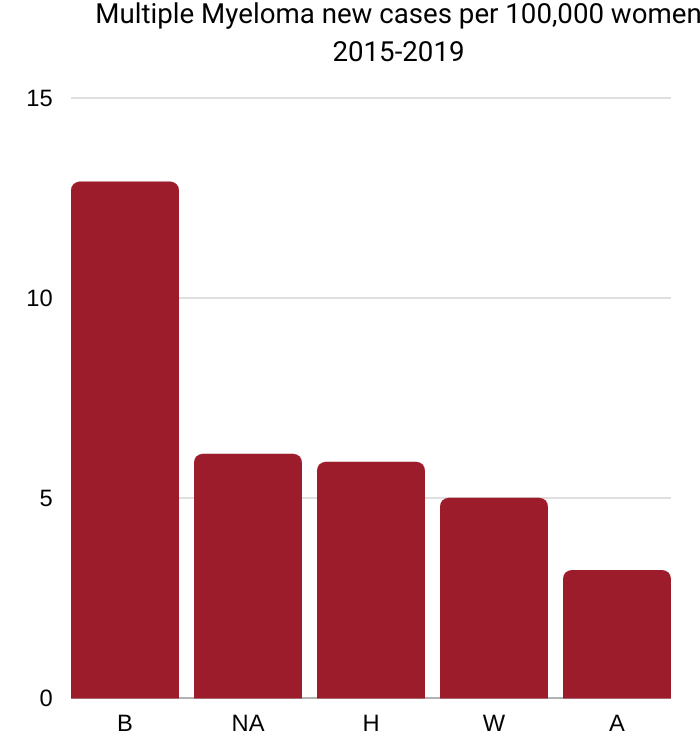
B=Black 12.9, NA=Native American 6.1,
H=Hispanic 5.9, W=White 5.0, A=Asian/Pacific Islander 3.2
Source: National Cancer Institute
Cancer Stat Facts: Myeloma

B=Black 17.0, NA=Native American 9.1,
H=Hispanic 8.1, W=White 8.1, A=Asian/Pacific Islander 5.1
Source: National Cancer Institute
Cancer Stat Facts: Myeloma

B=Black 5.1, NA=Native American 2.8,
W=White 2.3, H=Hispanic 2.2, A=Asian/Pacific Islander 1.3
Source: National Cancer Institute
Cancer Stat Facts: Myeloma
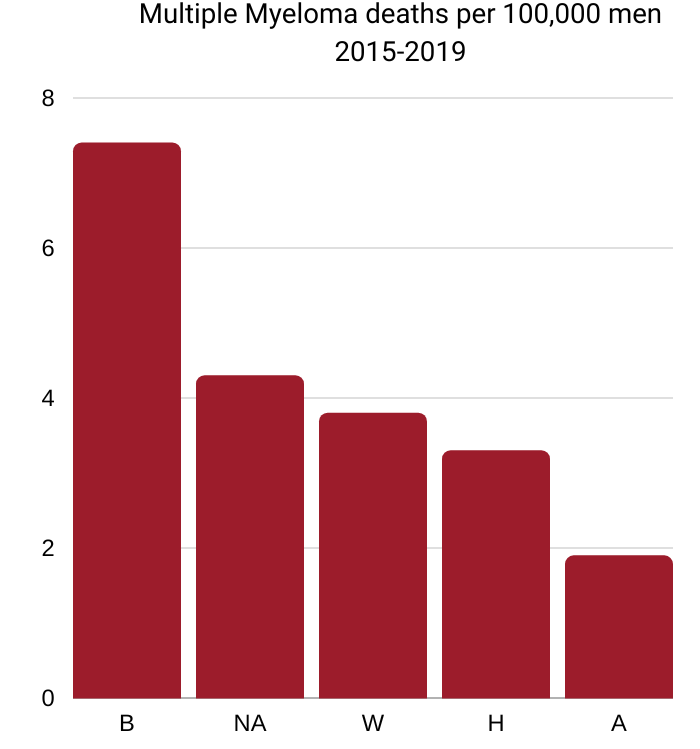
B=Black 7.4, NA=Native American 4.3,
W=White 3.8, H=Hispanic 3.3, A=Asian/Pacific Islander 1.9
Source: National Cancer Institute
Cancer Stat Facts: Myeloma
Men and Women Diagnosed with Mutiple Myeloma
Keith Elam aka Guru

Keith Elam, better known as the rapper Guru from the group Gang Starr, died at age 47 in 2010.
He was suffering from multiple myeloma and had been in a coma since a heart attack the month before.
Between 1989 and 2003, Gang Starr released six studio albums. As a solo artist, Guru was best known for his long-running jazz-meets-hip-hop series, Jazzmatazz.
Don Baylor

Baseball player Don Baylor, the 1979 American League Most Valuable Player, died of multiple myeloma at age 68 in 2017. He was diagnosed with the cancer 14 years before.
Baylor played for the Orioles, Athletics, Angels, Yankees, Red Sox and Twins over a 19-year career.
He was an All-Star and the MVP winner with the Angels in 1979, when he led the majors in Runs Batted In and runs and also set career highs in home runs and hits.
Colin Powell

Colin L. Powell, former Chairman of the Joint Chiefs of Staff and Secretary of State, died of complications from COVID-19 at age 84 in 2021.
His immune system had been compromised by multiple myeloma, for which he had been undergoing treatment.
Powell was fully vaccinated against COVID-19 and had been due to receive a booster shot, but had to postpone it when he fell ill. He had also been treated for early stages of Parkinson’s disease.
Marva Adams

Marva Adams was 34 years old in 1999 when she was diagnosed with multiple myeloma. “Before I was diagnosed, I had just terrible back pain,” Adams said. “It was just unbearable, and I didn’t know what it was.” (Bone pain is a hallmark symptom of multiple myeloma, and it’s common to feel it in the spine.)
“I ended up going to a number of different doctors before I was actually properly diagnosed.” After chemotherapy, she had a stem cell transplant in which healthy cells replace bad cells.
Today, her days now are “pretty normal,” she says. “I’m able to do anything I was able to do, if I didn’t have the myeloma.”
Adams, a Charlotte, North Carolina native, is now an ambassador for Bristol Myers Squibb’s Standing in the Gaap program to encourage and share her story with other African Americans living with multiple myeloma.
“If you’re having pain, you may not know what’s going on with you and you may want to ask your doctors to test you for myeloma,” Adams suggests.
Source: “Raising awareness of multiple myeloma’s impact on Blacks” by Aaliyah Bowden on The Charlotte Post website (November 8, 2021)
Rebecca Theodore-Vachon

Film and TV critic Rebecca Theodore-Vachon was diagnosed with multiple myeloma at age 47 in 2018. It was “devastating,” she said.
“I had never even heard of multiple myeloma before and now I had this thing in my body I had no control over. I felt like I was living on very borrowed time.”
Theodore-Vachon told no one except for a few close friends and two siblings, she later disclosed on twitter after the death of Colin Powell in October 2021. “I just resolved to take better care of myself and live my best life, in whatever shape and form it came in.”
Today, she is out of danger and has only to do bloodwork every six months. She is thankful for her medical team and a support network of friends and family.
Her message: “Multiple myeloma is a silent killer in the Black community. Please read up on this disease and talk to your doctors if you have any of the symptoms.”
"I thought my symptoms were related to a herniated disc"
“My name is Danielle. I have multiple myeloma. I thought my symptoms were related to a herniated disc and I was ignoring it basically because the pain would come and go.”
“In 2011 I was diagnosed. I was 46 years old. I felt myself at night sometimes just being angry that I am actually going through this, said Danielle who lives in Georgia.”
After three cycles of chemotherapy and two stem cell transplants, “I started to have a more positive outlook on life. It’s not that one day you wake up and you’re feeling better. It’s that you wake up and you realize that you feel better than you did the day before.”
“So, it’s a process that you have to go through and you just have to have that strength. You have to have that determination to understand I’m going to get through this. I’m going to get through this.”
A 4-minute video from Sanofi Genzyme, Sanofi Genzyme.
Multiple Myeloma Disparities
Incidence
Black men and women. Incidence of myeloma is 2.14 times higher in Black men and 2.6 times higher in Black women compared to White people. Median age at diagnosis is younger (66 versus 70 years of age). Incidence continued to increase steadily in Black women by about 2% per year from 2009 through 2018, whereas rates in Black men may be stabilizing in recent years, resembling trends in White men.
Source: American Cancer Society. Cancer Facts & Figures for African American/Black People 2022-2024.
The racial disparity is even greater before age 50, when incidence rates are 2.5 times higher in Black men and 3.5 times higher in Black women.
Source: American Cancer Society. Cancer Facts & Figures for African Americans 2019-2021. Atlanta: American Cancer Society, 2019
Family history
Black men and women. A family history of blood cancers is also associated with increased risk that is stronger among Black people than White people.
Source: American Cancer Society. Cancer Facts & Figures for African American/Black People 2022-2024.
Stage at diagnosis
Myeloma is preceded by an asymptomatic premalignant condition known as monoclonal gammopathy of undetermined significance (MGUS). Individuals with MGUS have a risk of progression to myeloma of about 1% to 2% a year.
Black men and women. MGUS is more prevalent and diagnosed at earlier ages in Black people than people of any other racial/ethnic group.
Source: American Cancer Society. Cancer Facts & Figures for African American/Black People 2022-2024.
Aggressive disease
Black men and women. The somewhat higher contemporary survival among Black people may reflect a lower prevalence of aggressive disease.
Source: American Cancer Society. Cancer Facts & Figures for African American/Black People 2022-2024.
Clinical trials
Black men and women. Only 4.5% of participants were African Americans in U.S. clinical trials for new drugs to treat multiple myeloma between 2003 and 2017. Considering that African Americans account for 13% of the U.S. population and 20% of individuals diagnosed with multiple myeloma, their under-representation in these clinical trials raises concerns regarding the applicability of study results to this population.
Source: “Recommendations on Eliminating Racial Disparities in Multiple Myeloma Therapies: A Step toward Achieving Equity in Healthcare” (2021)
Treatment
Black men and women. Black people have benefited less from recent improvements in treatment because of less access to care, lower utilization of new treatment, and more delays in treatment.
Source: American Cancer Society. Cancer Facts & Figures for African American/Black People 2022-2024.
5-year survival
Black men and women. The 5-year relative survival rate has improved from 29% during 1975-1977 to 58% during 2011-2017 among Black people versus 24% to 55% among White people. The somewhat higher contemporary survival among Black people may reflect a lower prevalence of aggressive disease. Indeed, Black people have benefited less from recent improvements in treatment because of less access to care, lower utilization of new treatment, and more delays in treatment.
Source: American Cancer Society. Cancer Facts & Figures for African American/Black People 2022-2024.
Mortality
Black men and women. Mortality rates are about twice as high in Black people as in White people. During 2015-2019, myeloma death rates declined by about 3% per year in Black women and 1% per year in Black men and White men and women due to improved treatment.
Source: American Cancer Society. Cancer Facts & Figures for African American/Black People 2022-2024.
"most disturbing is that it is often not recognized in time"
“Multiple myeloma is a unique disease in the African American community for many reasons, primarily because the disease is twice as common in Blacks than it is in Caucasians,” says Joseph Mikhael, MD, of the International Myeloma Foundation.
“But what’s perhaps most disturbing is that despite knowing that it is twice as common, it is often not recognized and not recognized in time. The average time to diagnosis from the onset of symptoms to an accurate diagnosis is significantly longer in the African American community than it would be in the Caucasian community.
Unfortunately, African Americans are less likely to receive the combinations of chemotherapy that are so important, the stem cell transplants that are very important in the treatment of myeloma, and access to clinical trials.
All of that has led to an inferior survival rate in African Americans compared to Caucasians. We’ve seen huge advances in survival in myeloma over the last decade, but for every 1.3 years gained by Caucasian patients, we’ve only seen 0.8 years gained in Black patients.
The disparity in multiple myeloma is confined not only to the African American community. We see this in many other vulnerable communities, in particular the Hispanic community where the disease is diagnosed at a younger age than we would typically see in the Caucasian community.”
A 3-minute video from the Patient Empowerment Network.
How Multiple Myeloma Affects People of Color

African Americans tend to have a better prognosis with multiple myeloma when they receive timely diagnosis and standard treatment, writes Shamard Charles, MD.
Research shows that disparities in multiple myeloma survival within the African American community stem from inferior treatment utilization and access rather than underlying pathogenesis. Unfortunately, many African-American people with multiple myeloma are not presented with life-saving options.
This underscores the importance of not only increasing health literacy in Black communities to help empower people to serve as their own advocates but also eliminating bias in the healthcare system.
See “Multiple Myeloma in the African American Community” by By Shamard Charles, MD, on the Verywell Health website (January 25, 2021)
Multiple Myeloma in African Americans

Researchers have discovered important differences in key cancer genes between African American and Caucasian myeloma patients.
African American myeloma patients were shown to have a lower-risk genetic profile and thus should achieve treatment results equal to—or even better than—those seen in other myeloma patient populations.
But barriers to appropriate treatment and lack of awareness of the disease (on the part of both patients and community health care providers) contribute to treatment approaches inconsistent with current recommended practice.
To overcome these barriers and more effectively manage their disease, African American patients need to stay informed about these unique disease and management considerations.
See “Multiple Myeloma in African Americans” on the Multiple Myeloma Research Foundation website (August 26, 2019)
Multiple Myeloma Programs

The M-POWER project of the International Myeloma Foundation is partnering with cities across the country to improve the short- and long-term outcomes of African-American patients with multiple myeloma. When barriers to early diagnosis and treatment are removed, African-American myeloma patients do just as well, or even better than, White individuals.
M-POWER is empowering health-care professionals, community leaders, neighborhoods and families to break down those barriers by raising myeloma awareness. M-Power programs are currently active in Atlanta, Baltimore, and Charlotte. Next will be New York City.

“Standing in the Gaap for African Americans with Multiple Myeloma” is an initiative to help spread the word about how multiple myeloma affects African Americans differently, in order to improve the quality of the care they receive. It was created in 2016 by the Celgene Corporation, a pharmaceutical company that makes cancer and immunology drugs.
According to the company, the meaning of the phrase “Standing in the Gaap” is: I am there for you, I have your back, I will provide the bridge to help you achieve your goals.
Since 2016, the Standing in the Gaap initiative has included live educational events for patients and healthcare providers, as well as a Facebook community of more than 61,000 members.
About Multiple Myeloma
If you have multiple myeloma or are close to someone who does, knowing what to expect can help you cope. Here you can find out all about multiple myeloma, including risk factors, symptoms, how it is found, and how it is treated. From the American Cancer Society.
What is Multiple Myeloma? Symptoms. Complications. Causes. Diagnosis. Treatment. The mission of The University of Texas MD Anderson Cancer Center is to eliminate cancer in Texas, the nation, and the world
Active Myeloma and Smoldering Myeloma. The Role of Plasma Cells. Symptoms. Risk Factors. Diagnosis & Staging. Treatment. From Memorial Sloan Kettering Cancer Center, “the world’s oldest and largest private cancer center.
Risk factors. Symptoms and signs. Diagnosis. Stages. Types of treatment. Questions to ask the health care team. About clinical trials. From Cancer.net, the American Society of Clinical Oncology’s patient information website.
What Is Multiple Myeloma? How Multiple Myeloma Impacts the Body. The Course of the Disease. Who Gets Multiple Myeloma? From the International Myeloma Foundation, “the first and largest organization focusing specifically on multiple myeloma.”
Most people just can’t make it to specialists like the ones on SurvivorNet. And they can’t afford to fly around the country getting second and third opinions. That’s okay. We’re bringing the expertise to you. We hope the information here creates power… and comfort.
Myeloma Made Simple
Hello, my name is Dr Joseph Mikhael and I am the Chief Medical Officer of the International Myeloma Foundation. It’s my privilege today to try and make Multiple Myeloma simple. Let’s start with the basics of blood because Multiple Myeloma is a cancer of the blood.
A 5-minute video from the International Myeloma Foundation.
"Knowing the signs and symptoms can give you the best chances of effective treatment"
African Americans are nearly twice as likely as Caucasians to develop myeloma. But new treatments are available that are helping myeloma patients live longer and maintain a good quality of life,” says Brion V. Randolph, MD, of the University of Tennessee Health Science Center.
Knowing the signs and symptoms of myeloma can help you to know when you need to talk to your doctor and give you the best chances of receiving early and effective treatment.
Bone pain is the most common early symptom of myeloma. Most patients feel pain in their back or ribs, but it can occur in any bone. Another common symptom of myeloma is frequent bone fractures, even during normal activities such as walking, lifting sneezing or coughing.
Some patients feel tired and weak due to low red blood cell counts, a condition called anemia. Also people with myeloma may get sick often or experience repeated infections.
A 4-minute video from the Leukemia & Lymphoma Society
"The treatments are improving, the quality of life is improving"
“Multiple myeloma is an incurable blood cancer that produces a lot of proteins that can cause damage to various organs, particularly the bones, as well as the kidney,” says the Mayo Clinic’s Rahma Warsame, MD.
Symptoms vary but can include fatigue, bone pain, anemia, and frequent infections.
While it’s not clear what causes multiple myeloma, doctors know that it begins with an abnormal plasma cell in your bone marrow, which produces too much protein inappropriately and multiplies rapidly.
“It’s when you find a little excess protein in the blood that indicates that you have the potential to become a multiple myeloma patient.”
Like many other cancers, the disease can be treated with medication, chemotherapy, radiation and even bone marrow transplant.
“The treatments are improving, the quality of life is improving. I’ve seen it in my own lifetime,” says Warsame.
A 1-minute video from the Mayo Clinic
"For last 10-15 years, the outlook has been transformed favorably by novel therapies."
“Multiple myeloma is a blood cancer that arises from a cell called a plasma cell, which is an important part of of one’s normal immune system producing antibodies,” says Paul G. Richardson, MD, of the Dana-Farber Cancer Institute in Boston.
What typically happens is that patients are identified with a high serum protein or some other end organ function of their disease, so that they can have a low hemoglobin or be slightly anemic and that can then trigger an investigation that finds the disease.
It starts as what’s called a monoclonal gammopathy democracy of uncertain significance (MGUS), becomes a smoldering process and then becomes an active disease. Unfortunately, in its active form, it can be very dangerous. It requires prompt therapy.
Until recently, unfortunately, it used to have a poor prognosis. But fortunately, for the last 10 to 15 years, the outlook has been transformed favorably by the advent of what we call novel therapies.
A 7-minute video from Cancer.Net
Early stages of multiple myeloma
MGUS: Monoclonal Gammopathy of Undetermined Significance
African Americans are more likely to have the earliest stage of myeloma, which is not cancer at all, but a benign condition called monoclonal gammopathy of undetermined significance or MGUS (usually pronounced as “EM-guss”).
Everyone who eventually develops active myeloma once had MGUS, but most people with MGUS never develop myeloma. Patients with MGUS have low levels in the blood of monoclonal protein known as M-protein, but no symptoms and are not treated. About 1% of MGUS patients progress to active myeloma per year.
Source: “What Are MGUS, Smoldering Multiple Myeloma, and Active Myeloma?” from the International Myeloma Foundation.
Smoldering Myeloma
Smoldering multiple myeloma (SMM) is an intermediate stage of myeloma between MGUS and active myeloma. Patients with SMM have a higher level of monoclonal protein and more abnormal plasma cells in the bone marrow than patients with MGUS. But SMM patients are asymptomatic and do not have any CRAB criteria (measurement of end-organ damage), or damage to red blood cells, kidneys, or bones.
The risk of progression to active myeloma for patients with standard-risk SMM is 10% per year for the first five years, 3% per year for the next five years, and 1-2% per year for the next 10 years. The standard of care for SMM is not to treat the patient but to “watch and wait.” There are clinical trials available to treat patients with SMM and “high-risk” SMM before their disease progresses.
Source: “What Are MGUS, Smoldering Multiple Myeloma, and Active Myeloma?” from the International Myeloma Foundation.
Screening for Multiple Myeloma?
Screening for Multiple myeloma is not routinely performed, mainly because the cancer is rare, currently not considered curable although treatment has improved dramatically, and a value to early detection has not been proven.
If multiple myeloma is suspected in an individual who is experiencing frequent infections, fatigue, anemia, bone pain or has laboratory findings such as low kidney function, high calcium or high total protein, testing may be recommended.
Several baseline tests that can be used for multiple myeloma screening, including:
Blood and urine tests for monoclonal proteins. These are the useless antibodies or antibody fragments that come from the clone of myeloma cells. Monoclonal proteins can usually be detected in the blood and/or urine of multiple myeloma patients. Because the monoclonal protein is sometimes found in patients who do not have multiple myeloma, further testing will be required if it is identified in order to reach a definitive diagnosis.
Imaging. In many patients with multiple myeloma, routine X-rays show distinct areas of bone erosion, general bone thinning and/or fractures, usually in the vertebrae, ribs, pelvic bones and thigh and upper arm bones.
Bone marrow aspiration and biopsy. A small sample of bone marrow is collected from a patient’s pelvis in the back for laboratory analysis to determine whether the bone marrow cells are comprised of an excessive amount of plasma cells.
Genetic and chromosomal tests. Specialized tests can reveal genetic or chromosomal abnormalities of the plasma cells that are usually associated with multiple myeloma.
Source: “Multiple Myeloma Screening” from the Moffitt Cancer Center.
Multiple Myeloma Clinical Trials
Clinical trials are critically important to the development of new multiple myeloma treatments, and to helping doctors better understand the disease itself. Almost all cancer treatments available today resulted from research conducted in clinical trials.
For many people with multiple myeloma, participation in a clinical trial may be a good option for treatment. Some patients worry that participating in a clinical trial may mean that they receive only a placebo and no actual treatment. In fact, all patients in a clinical trial receive treatment. One set of patients receives the standard treatment and the other set of patients receives the new treatment.
Physicians and nurses who conduct clinical trials are always the most familiar with the latest research and treatments, and the trials often take place at larger research institutions.
“Why should a patient consider participating in a clinical trial?
“It’s the only way we know how to do things. Everything that we have figured out about myeloma is because patients participated beforehand in clinical trials. It’s a way to pay it forward,” says Nina Shah, MD, of the University of California San Francisco.
“But aside from that, there’s an experience that a patient can have on a clinical trial that is really unlike other experiences they may have. They will be given the opportunity to understand a lot about their disease that maybe they may not have understood before and they may have the opportunity to try a treatment that might be beneficial.
One of the other things that’s really important is that clinical trials are sort of a concierge service because you have to be monitored very closely.”
A 2-minute video from the Patient Empowerment Network
Multiple Myeloma Support groups
The International Myeloma Foundation (IMF), the first and largest organization focusing specifically on multiple myeloma, is dedicated to improving the quality of life of myeloma patients while working toward prevention and a cure.
The Multiple Myeloma Research Foundation’s Patient Navigation Center is where multiple myeloma patients can connect with patient navigators —professionals specializing in cancer — for guidance, information, and support via phone, email or online web form.
Myeloma Link directly connects Black patients and caregivers to trusted, free myeloma information and support and enhances access to care and the latest treatments. Carried out by Leukemia & Lymphoma Society staff and volunteers in 13 Black communities across the country.
Active Multiple Myeloma Facebook Pages
To join a private group, visit the group’s Facebook page and click on the “Join” button to the right of a group’s name in order to send a request to the group’s moderator(s) for approval to join the group.
Free Downloads

From the Multiple Myeloma Research Foundation, a 34-page booklet designed primarily to help patients with newly diagnosed multiple myeloma and their friends and families better understand this disease.
Free download here
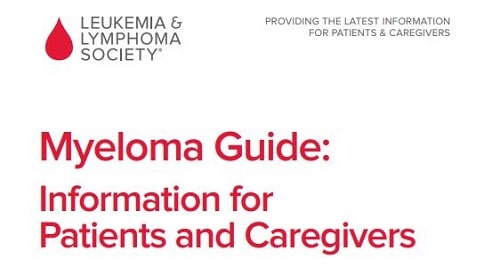
From the Leukemia & Lymphoma Society, a 52-page guide to the disease, treatment, clinical trials, follow-up care, terminology, and questions to ask.
Free download here

From the International Myeloma Foundation, an overview of myeloma, with a focus on getting the correct diagnosis, the tests you really need, when to begin treatment, which issues to consider when selecting your treatment regimen.
Free download here (top left corner)
Helps people with cancer talk with their doctors about the best treatment options for their disease, from the National Comprehensive Cancer Network, a not-for-profit alliance of 31 leading cancer centers devoted to patient care, research, and education.
Free download here
Publications

American Cancer Society
Cancer Facts & Figures for African Americans 2019-2021. Atlanta: American Cancer Society, 201

Susan G. Komen
Racial and Ethnic Differences in Breast Cancer (2020)

American Cancer Society
Cancer Facts & Figures for Hispanics/Latinos 2018-2020. Atlanta: American Cancer Society, 2018









